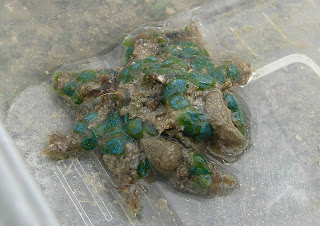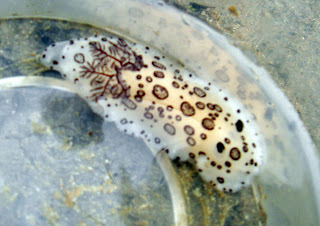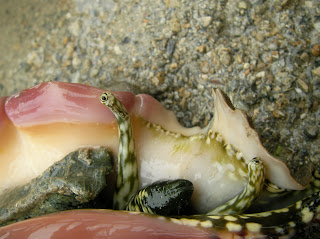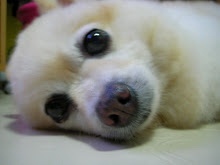I led my maiden guided walk exactly 1 year ago on 14 Nov 08 on the launch of Project Semakau. Although memories of guiding that VVIP group were still fresh in my mind (yes, we still lament about it once in a while), one year has so quickly passed us by! 1 year later, we are back on Pulau Semakau, still guiding a VVIP group - this time round were friends and family of the GVs.
I met Aida for lunch and both of us were praying really hard for good weather as dark clouds loomed the sky. Once again, Mother Nature was kind to us, and in fact blessed us with very good tide level , enabling us in sharing the amazing biodiversity of the island!
As we stepped out of the Secondary forest, the mangrove trees , as usual, were waiting for us faithfully. Because of its unique habitat (soft ground, low oxygen content, and high level of salinity), mangrove plants like the Bakau adapt to the environment by spreading its breathing roots out for better balance and grip. I read about the joint project ,in the Sunday times, between Singapore and Dutch to replant our mangroves, which is vital because they are a protective shield for coastal areas against waves. Studies have shown more homes might have been saved in the SEA 2004 Tsunami if not for the destruction of mangroves to make way for urban development. The mangrove ecosystem is also a nursery for many species of marine fish, shellfish and shrimps.
The male Orange Fiddler crabs (Uca vocans) were displaying their brightly-coloured pincer. Male fiddler crabs are identified by their single huge pincer that can be as huge as its body. This large pincer is mainly used to attract females and intimidate love rivals, similar to man who shows off and attract the opposite's attention with big flashy car etc. The bigger pincer really is 中看不中用 which is why the crab feeds on detritus by using is smaller spoon shaped pincer to scope sand to their mouth.
The Hunter-Seekers also found us a Soldier Crab (Dotilla myctiroides). Instead of flattened bodies, their bodies are round and they can walk forward unlike other crabs. The soldier crabs typically move in large groups. Like sand bubbler crabs, the soldier crab eats detritus by scraping sand to its mouth using its pincers . The sand is then discarded, resulting in small, round balls of sand.
Some of my guests squirmed when I told them that this small Sandfish Sea Cucumber (Holothuria scabra) is the edible delicacy we have on the table (though needs to be processed as it is mildly poisonous). Sea cucumbers are animals belonging to the family of sea stars. Most have tiny tube feet which are used to cling to surfaces. It feeds on detritus as it moves in the sand. Unlike human beings where blood is circulated through our body, water is circulated through the sea cucumbers’ body. Therefore, if we really have to, we shouldn’t take them out of the water for too long and not too far from the water surface.
Another familiar face is the Gong Gong (Strombus) whose population has dropped drastically over the years due to man's collection of them for food. They are scavengers that feed on decaying plant and animal matter (one good reason to think twice about eating them). To move around, they dig their strong knife-like operculum to push off the ground, just like pole vaulting.
We also witness how 2 animals lived in harmony - the Magnificient Giant Carpet Anemone (Heteractis magnifica Stichodactyla gigantea*) and the Sponge.
The sea anemone is home to the clownfish and is covered with short, sticky tentacles, these traps anything edible. They have stingers in their tentacles and simply entangle animals that blunder into them. These stingers inject a toxin that affects smaller animals.
The sponge, on the other hand, is a simple animal as it is made up of only a few types of cells. These cells do not form organs, so a sponge does not have a mouth, digestive system or circulatory system. Sponges filter feeds by pumping water in and out of itself. Because of the channels it has, it is a really good absorbent of water. Yup, this is the sponge that was used at home in the past. Those that we used now, fortunately, are synthetic sponges.
Like many ladies, the Wandering Cowrie (Cypraea errones) is one that is really good at maintaining its beauty. It covers its beautiful shell by a layer of fleshy mantle which works just like facial mask - it repairs and enlarges the shell, protects it from algae and abrasion to keep it smooth and glossy.
In the past, these shells of this beauty queen were used as currency for purchasing. More recently, they are collected for ornaments resulting in over collection.
As we walk along the edge of Sea grass meadow, we saw this Black Sea cucumber (Holothuria leucospilata) - first time sighted in Semakau though not seen in Semakau for the first time, its the first time we have a photo record*. Still a bonus on the 1st anniversary of Project Semakau... =)
Our first star of the day was the Sandsifting sea star aka Common Sea star (Archaster typicus). This sea star camouflages really well with the sand and feeds on organic detritus found in the sand/ mud. It moves around using its tube feet, which can also gather and handle food to the mouth located right in the middle on its underside.
I was pleasantly surprised to see the iconic Knobbly Seastar (Protorester nodosus) so early into the walk as we usually meet only after crossing the seagrass meadow. Named after the knobs on its body, it can grow up to 30cm wide! Clearly an example of not judging a book by its cover, this pretty Sea star is a ferocious predator to snails and clams. It holds them with its arms and tears them apart. Although stiff looking, it is actually a champion gymnast with flexible arms! This is one of endangered species due to over collection – sadly I’ve seen one in a shop in Plaza Singapore, looking really undernourished.
A Striped Hermit Crab (Clibanarius infraspinatus) was lying beside the Knobbly Sea star and stole a moment of fame from the Knobbly - because its my first time sighting it in Semakau! Hermit Crabs have 4 pairs of leg, but only the first 2 are true walking legs; the last 2 pairs supports the shell. They have a soft, long abdomen thus requires an empty shell for protection. As a hermit crab grows bigger, it has to find a bigger shell – just like us who upgrades to a landed/ condo from a HDB flat. I'm jealous of the hermit crab though, because it can test out the new shell first (while holding on to the old one) before switching. We can't do that, can we?
Chee Yee's group saw a cuttlefish and kindly showed it to us. I'm not sure of the ID though.
Cuttlefish possesses an internal structure called the cuttlebone which provides the cuttlefish with buoyancy. A smart invertebrate, it has chromatophores which are cells that allows it to change colour in a flash. They do this to communicate/ warn its fellow cuttlefishes or to camouflage from predators.
Just before crossing the seagrass lagoon, we were greeted by 2 Decorator or Velcro Crab (Camposcia retusa Micippa philyra*). While some crabs traps sediments using small hooked hairs, the Velcro crab plants algae, ascidians, sponges or anything possible on its body to camouflage into the surroundings. Without it moving, I can't tell where its legs/ eyes are at all!
We saw not 1, but 2 huge Noble Volutes (Cymbiola* nobilis) laying eggs (the white jelly-like balls in 1-2-1 patterns) ! Indeed a good indicator that the ecosystem is healthy and is suitable for reproduction. Often collected for its beautiful shell and sometimes for food, they have become rarer on our shores. Another good actor, the volute are ferocious predators of bivalves such as clams. I can't imagine having a pillow pressed against my head - thats how the volutes kills. They use their huge mascular foot to suffocate its prey, and sends its mouth into the shell the moment the prey opens its shell to breathe.
Our 3rd sea cucumber of the day was this Dragonfish Sea Cucumber (Stichopus sp.). Apart from the usual features of other Sea Cucumber, the Dragondish Sea Cucumber can melt and disintegrate when exposed in the sun for too long* It can also shed its skin when stressed, wile it can regenerate his species itself, it is a super long process, and a very painful one too, I would imagine. Thus, we should always leave the marine animals alone in their natural habitat.
This cute Polka-dot/ Funeral Nudibranch (Jorunna funebris) won a few hearts too! Nudibranchs are actually sea slugs and are slow moving dwellers. Named after its flower-like naked gills (meaning of its name in latin) exposed at the back of the body, these slugs are born with shells but lose them when they become adults. Thus, to protect themselves, some developed toxic or bad tasting glands on the skin and warns predators with their bright colours.
Meet our Olympic pole vault champion! The Spider conch (Lambis lambis) got its name from its long spider-like spines on its outer lip. It is very well camouflaged as the outer surface of the shell is covered with a thick layer of algae. Of course, the underside is the complete opposite and its beautiful shell is one of the reasons for its over collection. They don't mean to stare - the adorable large eyes at the end of its long tentacles was really just meant to enhance its vision. Like other conch snails, the animal to 'pole vault’ along the surface with its hooked like operculum, and we were to lucky to see this athlete in action!
Another first sighting - a Headshield slug (Philinopsis pilsbryi)!
Hairy Crabs (Pilumnus vespertilio) were also spotted by very keen eyes! This hairy crab is not the 大闸蟹 people eat. In fact it is mildly poisonous because of its diet that may contain toxic zoanthids. It
is called the hairy crab because it’s body and limbs are covered with long, silky hairs. These hairs trap sediments which allows the crab to blend perfectly with its surroundings. In the water, its hairs 'fluff up', and breaks up its body outline to avoid predator's attention.
Here's a picture of my group wading through the seagrass meadow - all looking quite happy! =)
On our way back, our group was casually looking at the crevices of a rock and was really pleased to find 2 Octopuses. Not sure why they are so near to the shore - Ron said they could be mating! This smartest invertebrate is another super gymnast and can fit into crevices of any shape. They are known to have the ability to learn and were seen opening jars. They can even recognise their tracks - makes me feel inferior because I lose my way and direction sometimes! Another deadly predator, it injects digestive juices to soften the prey’s tissues before slurping it up. Octopuses also have chromatophores which allows it to change colour almost instantly. It can even change its opacity and reflectiveness of its skin.
The intertidal walk was followed by a short coastal clean up. After all the hardwork, everyone was rewarded with beautiful scenario and yummy bbq food at the Southern point. I certainly hope that everyone enjoyed themselves! Looking forward to the 2nd anniversary of Project Semakau, till then, stay tuned!
*edited - Thanks Ron!

.JPG)
























No comments:
Post a Comment